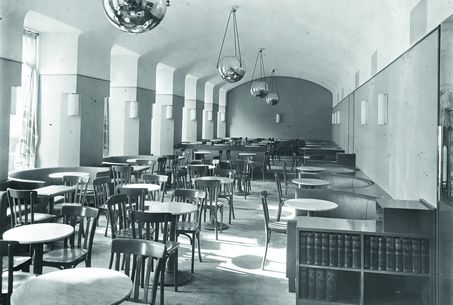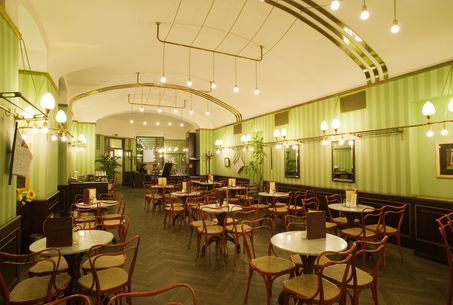show on

"You are worried, be it this or that - into the coffee house! You hate and despise the people and still cannot miss them - coffee house! You are no longer crediting yourself - coffee house!" Peter Altenberg

Ferdinand Rainer opened the Café Museum in the immediate vicinity of the K & K Hofoper, the Künstlerhaus and the then "wild" Secession. The establishment of the new coffee house was designed by Adolf Loos, the open-minded builder, who, true to his artistic attitude, placed great emphasis on simplicity. It was the first important assignment for Loos, who liked to come by with his first wife, the actress and feuilletonist Lina Loos. The simple furnishing of bentwood chairs was in complete contradiction to what was then customary plush furniture and triggered a true revolution in the design of coffee houses. This caused a "scandal" in the Café Museum, but the artists came in droves and raised it to the "place to be", the scenelokal. In colloquial speech also affectionately called "Secessionisten-Tschecherl" or "Café Nihilismus", became the Café Museum cult and it has remained to this day. Where did the "museum" get its name? Ludwig Frisch, the first proprietor of the "Café Museum", previously ran “Café zum Museum" behind the Kunsthistorisches Museum and simply handed over the old name to the new establishment.

The Pretscher family took over the Café Museum and, with the lifeblood and dedication of a true coffee house dynasty, succeeded successfully in the following decades through two world wars and economically difficult times. In 1911 the young South Tyrolean architect Josef Zotti, a pupil of the legendary Josef Hoffmann, was commissioned to design the Schanigarten (´sidewalk restaurant`). During the first decades of the twentieth century, the Café Museum was home to countless artists. The painters Gustav Klimt, Egon Schiele and Oskar Kokoschka, the writers Joseph Roth, Karl Kraus, Georg Trakl, Elias Canetti, Hermann Broch, Franz Werfel, Robert Musil and Leo Perutz, the composers Alban Berg, Franz Lehar and Oscar Straus as well as the architect Otto Wagner.

As the Loos creation showed signs of wear and tear, the architect Josef Zotti was now also commissioned to redesign the interior furnishings. The interior, with its cozy, faux leather booths, has been loved by the guests for more than 70 years. Artists, such as Albert Paris Gütersloh, Ernst Jandl and Friederike Mayröcker felt comfortable there. Since the 1950s, the Café Museum became a public living room and meeting place for artists, students and meanwhile more and more business people.

In 2003, however, a serious turning point came for the many regular customers. The Zotti fixtures was removed from the coffee house by a new operator and replaced by replicas from the original Loos-era, which did not really appeal to Viennese guests. The regular guests stayed away, resulting in a dramatic climax with the closure in 2009. Some of the original furniture of the Zotti period is still exhibited today in the Imperial Furniture Collection, a furniture museum in Vienna.

The Pretscher-Rokitansky family rented the Café Museum to the Querfeld family and thus took the first step towards a comeback, which demanded a clear attitude and steadfast faith in this unique place from the new operators. And what seemed almost unthinkable became true. The Querfeld family, the passionate owners, who knew the significance of warmth in every coffee house, left the interior design of the Café Museum to architect Hans-Peter Schwarz. In accordance with the plans of the brilliant architect Josef Zotti, including the beautiful silver globe light fixtures, he revived the whole interior.
Irmgard and Berndt Querfeld even succeeded in repurchasing individual pieces of the original furniture, which were a stylish supplement. With the reopening in October 2010, the wish of many of the ´homeless’ regular guests became true. Since 2011, the Café Museum has also regularly been hosting public readings with audience discussions, in the tradition of an artistic meeting place. Irmgard Querfeld and her team pay close attention to the Café Museum, which has been entrusted to them. This makes it particularly beautiful to see why Viennese coffee house culture has become an "intangible UNESCO cultural heritage".
show on